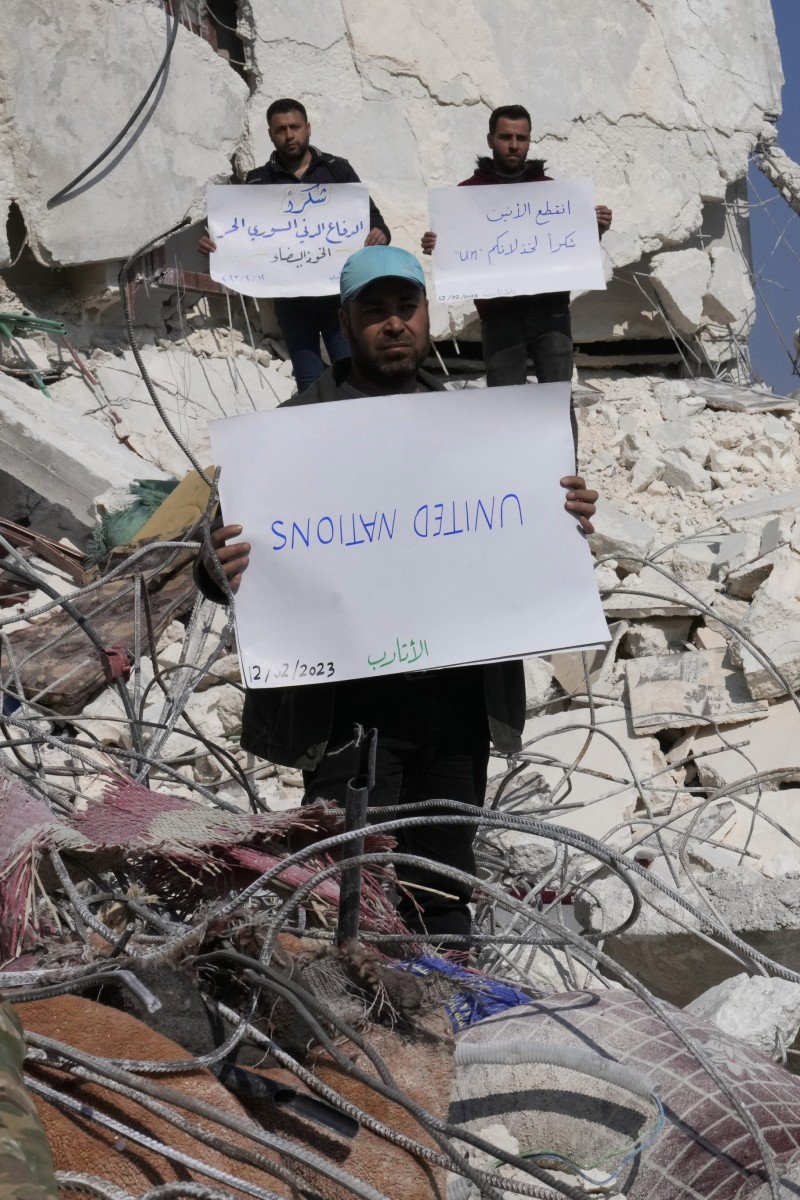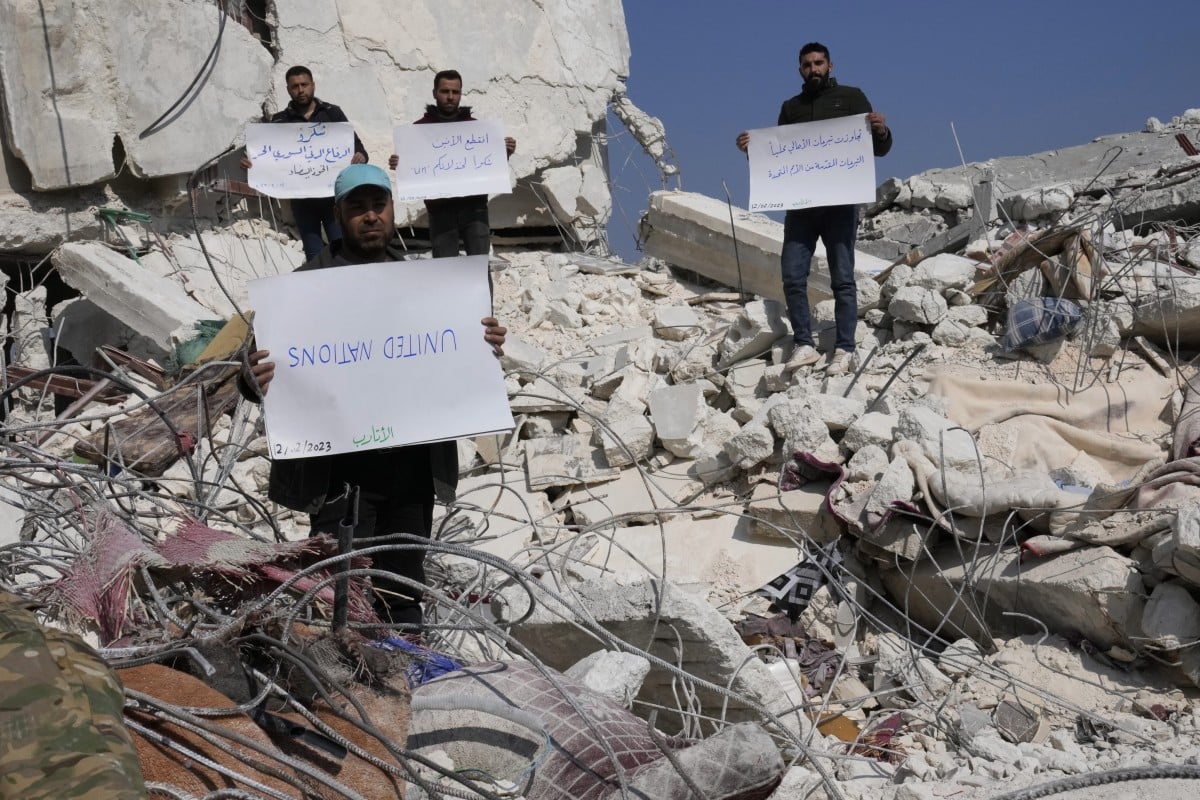
5-minute listening: 10 deadliest earthquakes of the 21st century
- Practise your English with our short listening exercises: play the audio linked below; answer the questions; and check the answers at the bottom of the page
- From Indonesia’s devastating 2004 tsunami to the recent quakes in Turkey and Syria, this natural disaster has the power to wreak havoc
 Men in Syria stand amid the rubble of homes destroyed by the deadly earthquakes earlier this month with placards criticising delays in getting UN aid to the area. Photo: AP
Men in Syria stand amid the rubble of homes destroyed by the deadly earthquakes earlier this month with placards criticising delays in getting UN aid to the area. Photo: APQuestions
1. What natural disaster took place after an earthquake occurred off Sumatra’s coast?
A. landslide
B. tsunami
C. wildfire
D. hurricane
2. How many people lost their homes when Haiti was struck by an earthquake?
A. 10,000
B. 24,000
C. 200,000
D. 1.5 million
3. According to the podcast, how could some fatalities from the quake in Sichuan have been avoided?
A. if the schools had been properly constructed
B. if the residents had evacuated earlier
C. if the survivors had received help on time
D. all of the above
4. Which word can replace “shoddy” in the podcast?
A. worthless
B. paltry
C. poor
D. garish
5. If someone is “corner-cutting”, they are doing something ...
A. quickly but in a less thorough way than they should.
B. while paying careful attention to every detail.
C. in a hesitant manner because they are not sure that it is the right thing to do.
D. with a lot of excitement and interest.
6. When was the last time Turkey was hit by an earthquake with a magnitude larger than 7.0?
A. 1990
B. 2003
C. 2020
D. information not given
7. What are most of the buildings in Bam made of according to the podcast?
A. sticks and stones
B. stone and mortar
C. mud and bricks
D. bricks and steel
8. Based on information from the podcast, which country listed below was struck by an earthquake with a magnitude above 8.5?
A. Iran
B. Japan
C. Haiti
D. India
9. If a place is “uninhabitable”, it is ...
A. a place with more than 1,000 years of history.
B. being sold at a very cheap price.
C. a place of worship for the locals.
D. not fit to live in.
10. Fill in the following table using information from the podcast.
Answers
1. B
2. D
3. A
4. C
5. A
6. D
7. C
8. B
9. D
10. (i) 2001; (ii) Iran; (iii) 2015; (iv) 9,000; (v) Haiti; (vi) 200,000
Script
Voice 1: The massive earthquake that struck Turkey and Syria earlier this month is the fifth deadliest this century. Here is a list of the 10 worst quakes since 2000, according to their death tolls.
Voice 2: On December 26, 2004, a massive 9.1-magnitude earthquake struck off the coast of Sumatra, a large island in Indonesia. It triggered a tsunami that killed more than 230,000 people throughout Southeast Asia, including 170,000 in Indonesia alone. Waves 30 metres high, travelling at 700km/h, swallowed everything in their path.
Voice 1: A magnitude-7 quake on January 12, 2010, devastated the capital of Haiti, Port-au-Prince, and the surrounding region. The quake cut the country off from the rest of the world for 24 hours, killing over 200,000 people, leaving 1.5 million homeless and shattering much of Haiti’s frail infrastructure. In October of the same year, Haiti was also hit by a cholera epidemic introduced by Nepalese peacekeepers who arrived after the quake. It killed more than 10,000 people.
Voice 2: More than 87,000 people, including 5,335 school pupils, were left dead or missing when a 7.9-magnitude quake struck China’s southwestern Sichuan province on May 12, 2008. The quake caused outrage after it emerged that 7,000 schools were badly damaged, triggering accusations of shoddy construction, corner-cutting and possible corruption, especially as many other buildings nearby held firm.
Voice 1: An earthquake that occurred on October 8, 2005, killed more than 73,000 people – the vast majority of them in Pakistan’s North-West Frontier Province and the Pakistani-administered zone of Kashmir. A further 3.5 million were displaced.
Voice 2: On February 6, 2023, a 7.8-magnitude quake took place near the Turkish city of Gaziantep, home to around 2 million people. Followed by a slightly smaller 7.5-magnitude tremor and many aftershocks, the quakes devastated entire sections of major cities in southeastern Turkey and the north of war-ravaged Syria. It was the biggest quake in Turkey in nearly a century, and the death toll crossed more than 47,000 two weeks after the disaster.
Voice 1: A 6.6-magnitude quake in southeastern Iran on December 26, 2003, destroyed the ancient mud-brick city of Bam, killing at least 31,000 people. Nearly 80 per cent of Bam’s infrastructure was damaged and the desert citadel crumbled. It was once considered the world’s largest adobe building.
Voice 2: A massive 7.7-magnitude earthquake on January 26, 2001, hit the western Indian state of Gujarat, killing more than 20,000 people. The quake flattened buildings across the state, with many fatalities in the town of Bhuj near the border with Pakistan.
Voice 1: On March 11, 2011, Japan was struck by an enormous 9.0-magnitude earthquake, unleashing a towering tsunami. Around 18,500 people were left dead or missing as the wall of water travelling at the speed of a jet plane levelled communities along the northeastern coast. The ensuing meltdown at the Fukushima Daiichi nuclear plant blanketed nearby areas with radiation. Some towns were uninhabitable for years because of the radiation, and thousands of residents were displaced.
Voice 2: A 7.8-magnitude earthquake on April 25, 2015, struck in central Nepal, triggering avalanches and landslides across the Himalayan nation, destroying schools and hospitals. The quake killed almost 9,000 people and rendered millions homeless. It also reduced more than a hundred monuments to rubble, including centuries-old temples and royal palaces in the Kathmandu valley.
Voice 1: On May 26, 2006, a 6.3-magnitude quake rocked the southern coast of the Indonesian island of Java, near the city of Yogyakarta, killing around 6,000 people. More than 420,000 were left homeless and around 157,000 houses were destroyed.